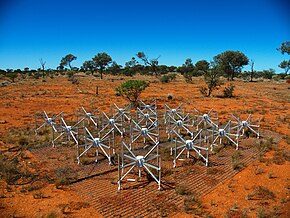 An individual MWA-32T tile | |
| Part of | Murchison Radio-astronomy Observatory |
|---|---|
| Location(s) | Western Australia, AUS |
| Coordinates | 26°42′12″S 116°40′16″E / 26.7033°S 116.671°E |
| Wavelength | 3.75, 1 m (80, 300 MHz) |
| Built | 2007–2012 |
| Telescope style | radio interferometer |
| Diameter | 3 km (9,842 ft 6 in) |
| Collecting area | 512 m2 (5,510 sq ft) |
| Website | www |
| | |
The Murchison Widefield Array (MWA) is a joint project between an international consortium of organisations to construct and operate a low-frequency radio array. 'Widefield' refers to its very large field of view (on the order of 30 degrees across). Operating in the frequency range 70–300 MHz, the main scientific goals of the MWA are to detect neutral atomic Hydrogen emission from the cosmological Epoch of Reionization (EoR), to study the Sun, the heliosphere, the Earth's ionosphere, and radio transient phenomena, as well as map the extragalactic radio sky. It is located at the Murchison Radio-astronomy Observatory (MRO).
Along with the Australian Square Kilometre Array Pathfinder (ASKAP), also at the MRO, and two radio telescopes in South Africa, the Hydrogen Epoch of Reionization Array (HERA) and MeerKAT, the MWA is one of four precursors to the international project known as the Square Kilometre Array (SKA).
